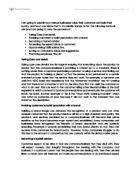What is an integrated supply chain? Explain how two selected businesses have been able to integrate their supply chains.
Tom Ward Unit 31 Ian Davies
What is an ‘integrated supply chain’? Explain how two selected businesses have been able to integrate their supply chains. P2
An integrated supply chain includes not only the suppliers but also the consumers. It consists of the flow of goods, money and information from the suppliers to the end consumer. In an non integrated supply chain, each stage of the business the chain will keep a stock of goods to be able to meet unexpected hike in demand. The total inventory and costs of a supply chain can be big if there are many levels in the supply chain. Examples of the costs are less cooperation between members of the supply chain, higher stock levels and lower quality levels.
Many businesses now use “Just in Time” (JIT) this is simply an inventory control system that schedules materials to arrive and leave, as they are needed. The inventory system is all about having the correct material, at the right place, at the right time and in the exact amount. The many reasons why companies use this now is because the JIT process compared to the traditional process is so much simpler, as the traditional process is very jumbled, has long cycles and is difficult to schedule. Whereas the JIT process is easy to schedule, has short cycles, has product focused cells and flexible equipment. The benefits of using this are that;







